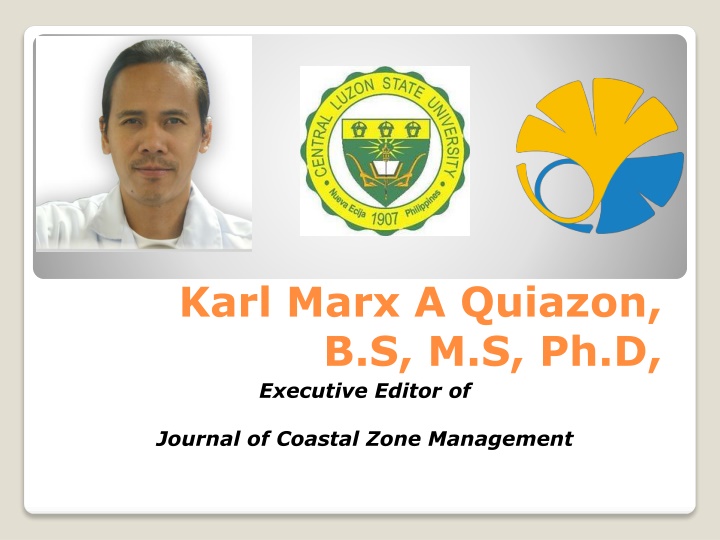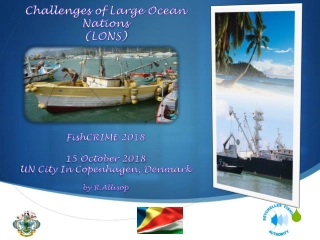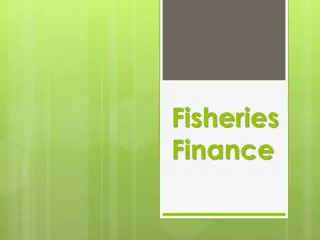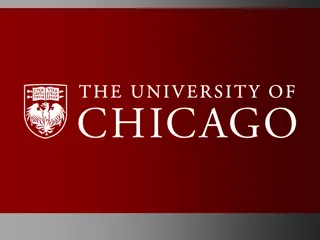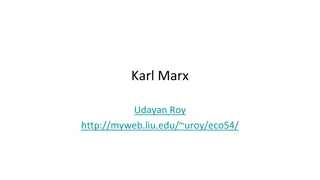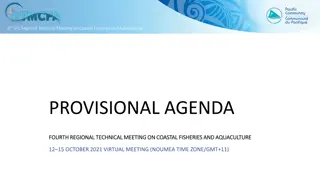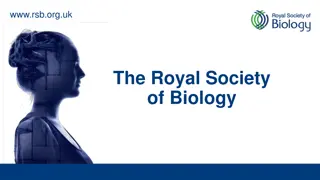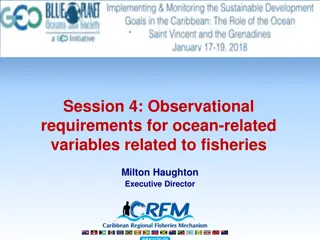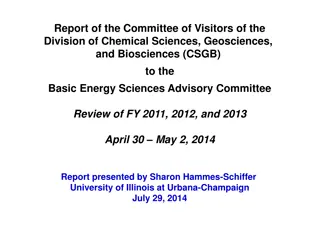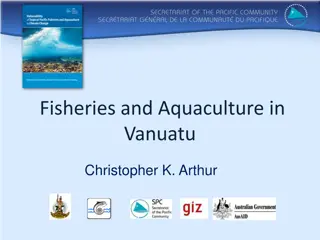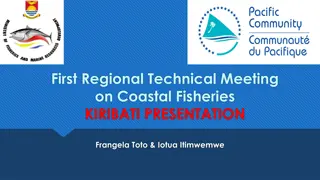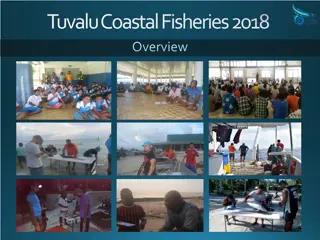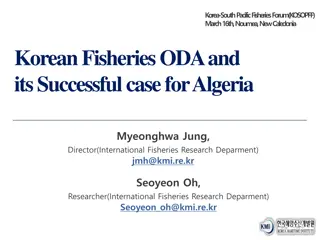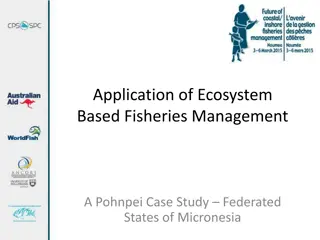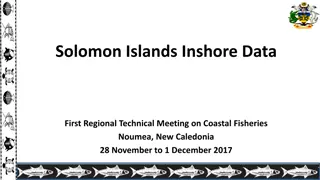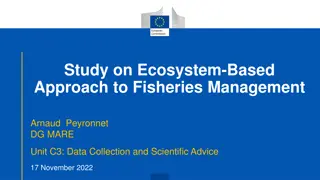Dr. Karl Marx A. Quiazon - Expert in Aquatic Biosciences and Fisheries Management
Dr. Karl Marx A. Quiazon is a highly accomplished academic and researcher in the field of aquatic biosciences and fisheries management. With a Ph.D. from the University of Tokyo, Japan, he has extensive experience in fish diseases and aquaculture. He has held various academic positions in the Philippines and is currently a Post-Doctoral Fellow at the University of Tokyo. Dr. Quiazon has published numerous research papers and is a respected expert in his field.
Download Presentation

Please find below an Image/Link to download the presentation.
The content on the website is provided AS IS for your information and personal use only. It may not be sold, licensed, or shared on other websites without obtaining consent from the author.If you encounter any issues during the download, it is possible that the publisher has removed the file from their server.
You are allowed to download the files provided on this website for personal or commercial use, subject to the condition that they are used lawfully. All files are the property of their respective owners.
The content on the website is provided AS IS for your information and personal use only. It may not be sold, licensed, or shared on other websites without obtaining consent from the author.
E N D
Presentation Transcript
Karl Marx A Quiazon, B.S, M.S, Ph.D, Executive Editor of Journal of Coastal Zone Management
Dr. Karl Marx A Quiazon did his B.S. in Inland fisheries (1997) and M.S. Aquaculture (2003) from Central Luzon State University, Philippines. He completed his M.S. in Aquatic biosciences (Fish Diseases) (2006) and Ph.D. in Aquatic biosciences (Fish Diseases) (2009) from the The University of Tokyo, Japan. Presently, He is a Post Doctoral fellow in the Laboratory of Fish Diseases, Graduate School of Agricultural and Life Sciences, The University of Tokyo, Japan. Dr. Karl Marx A Quiazon has been an Associate Professor IV, Assistant Professor and Instructor at the College of Fisheries, CLSU, Philippines. Dr. Karl Marx A Quiazon has held the responsibility of Department Chairman for Department of Aquaculture, Philippines and also Research Coordinator for The College of Fisheries, Philippines. Dr. Karl Marx A Quiazon has a number of International and national research projects under his name and holds a position of an expert referee or reviewer for many of the journals also. Biography
Fisheries, Aquaculture. Research Interests
1. Quiazon KMA, T.Yoshinaga, H. Doi, J. Araki, K. Ogawa. 2014. First description of male Philometra thaiensis Moravec, Fiala et Dykova, 2004 (Nematoda: Philometridae) from the body cavity of the eyespot pufferfish Tetraodon biocellatus Tirant, and evolutionary relationships of thgis species with other dracunculoids as inferred from SSU rRNA gene sequence. HELMINTHOLOGIA 51: 236-245. 2. Quiazon KMA, K. Zenke, T. Yoshinaga. 2013. Molecular characterization and comparison of four Anisakis allergens between Anisakis simplex sensu stricto and Anisakis pegreffii in Japan. MOLECULAR AND BIOCHEMICAL PARASITOLOGY 190: 23 26. 3. Quiazon, K.M.A., M.D. Santos, and T. Yoshinaga. 2013. Anisakis species (Nematoda: Anisakidae) of dwarf sperm whale Kogia simus (Owen, 1866) stranded off the Pacific coast of southern Philippine archipelago. VETERINARY PARASITOLOGY, 197: 221 230. 4. Quiazon, K.M.A. and T. Yoshinaga. 2013. Gonad-infecting philometrid Philometra philippinensis sp. nov. (Nematoda, Philometridae) from bigeye barracuda Sphyraena forsteri Cuvier (Sphyraenidae) off Mariveles, Bataan Province, Philippine archipelago. ACTA PARASITOLOGICA, 58: 504 514. 5. Quiazon, K.M.A. and F. Moravec. 2013. Dentirumai philippinensis n. gen., n. sp. (Nematoda: Philometridae): a new tissue infecting philometrid nematodes from the loach goby Rhyacichthys aspro (Valenciennes, 1837) (Rhyacichthydae) in the Philippines. JOURNAL OF HELMINTHOLOGY 87: 59 65. Recent Publications
6. Quiazon, K.M.A., T. Yoshinaga, and K. Ogawa. 2011. Distribution of Anisakis species larvae from fishes of the Japanese waters. PARASITOLOGY INTERNATIONAL 60: 223 226. 7. Quiazon, K.M.A., T. Yoshinaga, and K. Ogawa. 2011. Experimental challenge of Anisakis simplex sensu stricto and Anisakis pegreffii (Nematoda: Anisakidae) in rainbow trout and olive flounder. PARASITOLOGY INTERNATIONAL 60: 126 131. 8. Quiazon, K.M.A., T. Yoshinaga, K. Ogawa and M.D. Santos. 2009. Identification of larval Anisakis spp.(Nematoda: Anisakidae) in Alaska pollock (Theragra chalcogramma) in northern Japan using morphological and molecular markers. JOURNAL OF PARASITOLOGY 95: 1227-1232. 9. Quiazon, K.M.A., T. Yoshinaga, and K. Ogawa. 2008a. Taxonomical study into two new species of Philometra (Nematoda: Philometridae) previously identified as Philometra lateolabracis (Yamaguti, 1935). FOLIA PARASITOLOGICA 55: 29-41. 10. Quiazon, K.M.A., T. Yoshinaga, K. Ogawa, and R. Yukami. 2008b. Morphological differences between larvae and in vitro-cultured adults of Anisakis simplex (sensu stricto) and Anisakis pegreffii (Nematoda: Anisakidae). PARASITOLOGY INTERNATIONAL 57: 483-489. 11. Quiazon, K.M.A., T. Yoshinaga, and K. Ogawa. 2008c. Philometra sawara sp.n. and a redescription of Philometra sciaenae Yamaguti, 1945 and Philometra nemipteri Luo, 2001 (Nematoda: Philometridae): a morphological and molecular approach. FOLIA PARASITOLOGICA 55: 277- 290. Recent Publications
Research Coordinator, June 2010 November 2011 College of Fisheries, CLSU, PHILIPPINES Coordinates and implements all research programs in the College of Fisheries Assist and monitor all research undertakings of all students in the College of Fisheries.
International Project leader (Philippines), February 2013 January 2016 International Consortium project (Spain, Italy, Norway, France, Faroe Islands, Germany, Denmark, Croatia, England, Netherlands, Phillippines, Vietnam and China): Seventh Framework Programme - Parasite Risk Assessment with Integrated Tools in EU fish production value chains . (GA No: 312068). RESEARCH PROJECTS
International Member, September 2010 present International Society for Southeast Asian Agricultural Sciences Central Luzon Chapter Member, March 2005 present Japanese Society of Fisheries Science (JSFS) Member, April 2003 present Science and Technology Advisory Council in Japan (STAC-J) SCIENTIFIC ORGANIZATIONS
Generally, a fishery is an entity engaged in raising or harvesting fish which is determined by some authority to be a fishery. According to the FAO, a fishery is typically defined in terms of the "people involved, species or type of fish, area of water or seabed, method of fishing, class of boats, purpose of the activities or a combination of the foregoing features". The definition often includes a combination of fish and fishers in a region, the latter fishing for similar species with similar gear types. Introduction
A salmon fishery with salmon spawning within the Becharof Wilderness in southwestern Alaska
A fishery may involve the capture of wild fish or raising fish through fish farming or aquaculture. Directly or indirectly, the livelihood of over 500 million people in developing countries depends on fisheries and aquaculture. Overfishing, including the taking of fish beyond sustainable levels, is reducing fish stocks and employment in many world regions. Professional Prospects
Issues that our Profession will face Most fisheries are wild fisheries, but farmed fisheries are increasing. Farming can occur in coastal areas, such as with oyster farms, but more typically occur inland, in lakes, ponds, tanks and other enclosures.
Definition Fisheries is a place where fish are reared for commercial purposes. (or) a fishing ground or area where fish are caught. (or) the occupation or industry of catching or rearing fish.
Fisheries are harvested for their value (commercial, recreational or subsistence). They can be saltwater or freshwater, wild or farmed. Examples are the salmon fishery of Alaska, the cod fishery off the Lofoten islands, the tuna fishery of the Eastern Pacific, or the shrimp farm fisheries in China. Capture fisheries can be broadly classified as industrial scale, small-scale or artisanal, and recreational.
Approved By E-signature:
